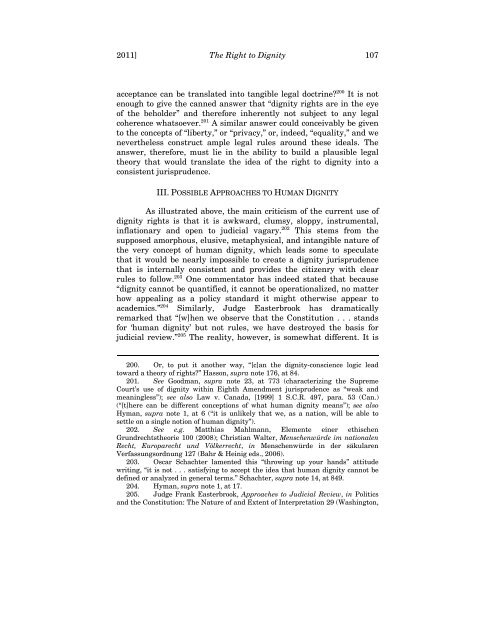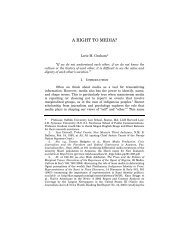The Right to Dignity Rex D. Glensy - Columbia Law School
The Right to Dignity Rex D. Glensy - Columbia Law School
The Right to Dignity Rex D. Glensy - Columbia Law School
Create successful ePaper yourself
Turn your PDF publications into a flip-book with our unique Google optimized e-Paper software.
2011] <strong>The</strong> <strong>Right</strong> <strong>to</strong> <strong>Dignity</strong> 107<br />
acceptance can be translated in<strong>to</strong> tangible legal doctrine? 200 It is not<br />
enough <strong>to</strong> give the canned answer that “dignity rights are in the eye<br />
of the beholder” and therefore inherently not subject <strong>to</strong> any legal<br />
coherence whatsoever. 201 A similar answer could conceivably be given<br />
<strong>to</strong> the concepts of “liberty,” or “privacy,” or, indeed, “equality,” and we<br />
nevertheless construct ample legal rules around these ideals. <strong>The</strong><br />
answer, therefore, must lie in the ability <strong>to</strong> build a plausible legal<br />
theory that would translate the idea of the right <strong>to</strong> dignity in<strong>to</strong> a<br />
consistent jurisprudence.<br />
III. POSSIBLE APPROACHES TO HUMAN DIGNITY<br />
As illustrated above, the main criticism of the current use of<br />
dignity rights is that it is awkward, clumsy, sloppy, instrumental,<br />
inflationary and open <strong>to</strong> judicial vagary. 202 This stems from the<br />
supposed amorphous, elusive, metaphysical, and intangible nature of<br />
the very concept of human dignity, which leads some <strong>to</strong> speculate<br />
that it would be nearly impossible <strong>to</strong> create a dignity jurisprudence<br />
that is internally consistent and provides the citizenry with clear<br />
rules <strong>to</strong> follow. 203 One commenta<strong>to</strong>r has indeed stated that because<br />
“dignity cannot be quantified, it cannot be operationalized, no matter<br />
how appealing as a policy standard it might otherwise appear <strong>to</strong><br />
academics.” 204 Similarly, Judge Easterbrook has dramatically<br />
remarked that “[w]hen we observe that the Constitution . . . stands<br />
for ‘human dignity’ but not rules, we have destroyed the basis for<br />
judicial review.” 205 <strong>The</strong> reality, however, is somewhat different. It is<br />
200. Or, <strong>to</strong> put it another way, “[c]an the dignityconscience logic lead<br />
<strong>to</strong>ward a theory of rights?” Hasson, supra note 176, at 84.<br />
201. See Goodman, supra note 23, at 773 (characterizing the Supreme<br />
Court’s use of dignity within Eighth Amendment jurisprudence as “weak and<br />
meaningless”); see also <strong>Law</strong> v. Canada, [1999] 1 S.C.R. 497, para. 53 (Can.)<br />
(“[t]here can be different conceptions of what human dignity means”); see also<br />
Hyman, supra note 1, at 6 (“it is unlikely that we, as a nation, will be able <strong>to</strong><br />
settle on a single notion of human dignity”).<br />
202. See e.g. Matthias Mahlmann, Elemente einer ethischen<br />
Grundrechtstheorie 100 (2008); Christian Walter, Menschenwürde im nationalen<br />
Recht, Europarecht und Völkerrecht, in Menschenwürde in der säkularen<br />
Verfassungsordnung 127 (Bahr & Heinig eds., 2006).<br />
203. Oscar Schachter lamented this “throwing up your hands” attitude<br />
writing, “it is not . . . satisfying <strong>to</strong> accept the idea that human dignity cannot be<br />
defined or analyzed in general terms.” Schachter, supra note 14, at 849.<br />
204. Hyman, supra note 1, at 17.<br />
205. Judge Frank Easterbrook, Approaches <strong>to</strong> Judicial Review, in Politics<br />
and the Constitution: <strong>The</strong> Nature of and Extent of Interpretation 29 (Washing<strong>to</strong>n,















